IO流
作用:用于读写数据的(可以读写文件,或网络中的数据…)
认识IO流

- 字节输入流 InputStream(读字节数据的)
- 字节输出流 OutputStream(写字节数据出去的)
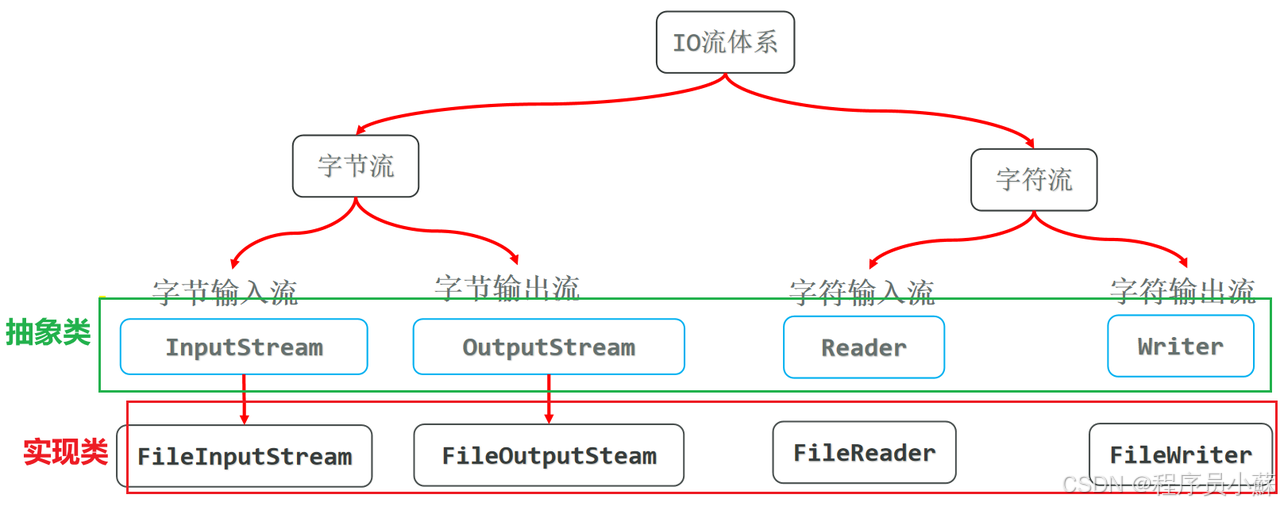
字节流
文件字节输入流(FileInputStream)
作用:以内存为基准,可以把磁盘文件中的数据以字节的形式读入到内存中去


a.txt文件
Java
//1.获取文件的字节输入流对象
InputStream in = new FileInputStream("module\\a3.txt");
//2.读取字节数据(一个一个字节读取)
/*int r = in.read();
System.out.println((char)r);//a
r = in.read();
System.out.println((char)r);//b
r = in.read();
System.out.println((char)r);//c
r = in.read();
System.out.println((char)r);//肯定不是“你”
byte[] bytes = new byte[3];
r = in.read(bytes);//r是读取的字节数组里面存储数据的长度
System.out.println("字节数组读取数据的长度:"+r);//3
System.out.println("读到的数据:"+new String(bytes));//你*/
byte[] bytes = new byte[3];
int len = -1;// 因为读取文件读不到数据就会返回读取长度为-1
while ((len = in.read(bytes))!=-1){
//不能直接打印bytes,有可能bytes残留上一次读取的字节数据,所以本次读取多少长度就转换为字符串对应的长度
//读取len长度,将从0位置开始+读取的字节长度转化为字符串输出
System.out.println("读到的数据:"+new String(bytes,0,len));
}
//3.释放资源
in.close(); |
注意事项:
- 使用FilelnputStream每次读取一个字节,读取性能较差,并且读取汉字输出会乱码。
- 使用FilelnputStream每次读取多个字节,读取性能得到了提升,但读取汉字输出还是会乱码。
解决方法:
- 定义一个与文件一样大的字节数组,一次性读取完文件的全部字节。
一次性读完全部字节(不推荐)

注意事项
- 如果文件过大,创建的字节数组也会过大,可能引起内存溢出。
读取文本适合用字符流;字节流适合做数据的转移,比如:文件复制
文件字节输出流(FileOutputStream)
作用:以内存为基准,把内存中的数据以字节的形式写出到文件中去。
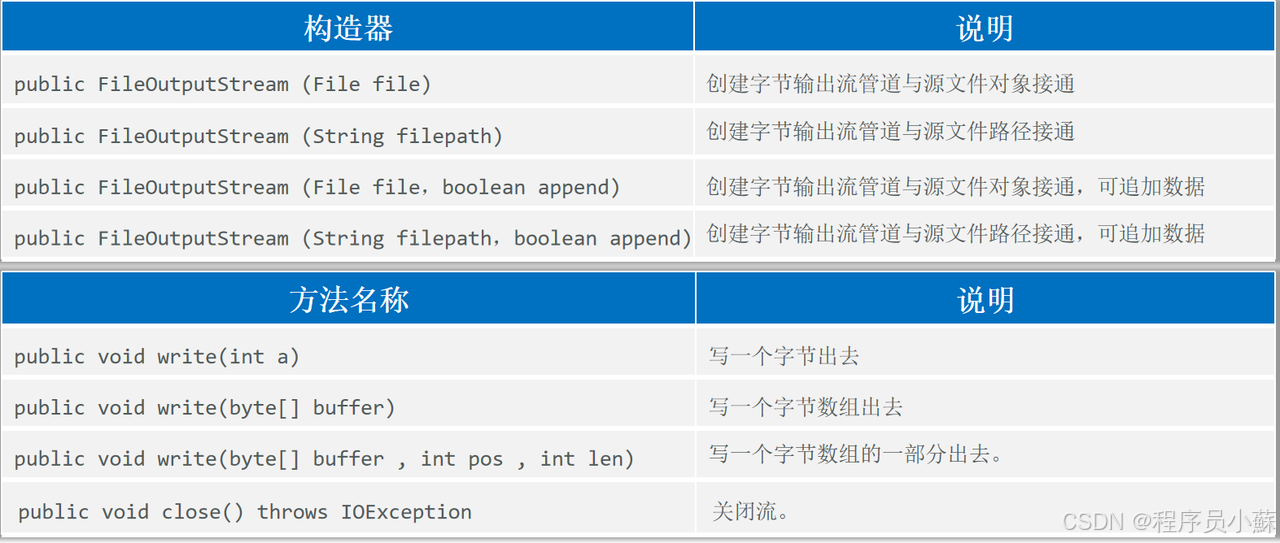
Java
// 1.获取文件的字节输出流对象
//OutputStream out = new FileOutputStream(new File("module/a5.txt"));//覆盖方式
OutputStream out = new FileOutputStream(new File("module/a5.txt"), true);//追加方式
// 2.输出数据
// 一个字节
out.write('a');
out.write(97);
// 字符串=》字节数组
out.write("你好".getBytes());
// 字节数组
byte[] bytes = {97, 98, 99};
out.write(bytes);
// 写入换行
out.write('\n');
out.write("\r\n".getBytes());//这个也是换行,推荐使用,windows换行推荐使用\r\n
out.write('a');
// 部分输出
out.write("你好abc".getBytes(), 0, 6);//从0的位置,输出6个字节长度
// 3.释放资源
out.close(); |
- 实现写数据的追加操作:创建FileOutpuStream的对象,在构造器第二个参数声明true.
文件复制
- 任何文件的底层都是字节,字节流做复制,是一字不漏的转移完全部字节,只要复制后的文件格式一致就没问题!
Java
//1.获取文件的字节输入流对象
InputStream in = new FileInputStream("源文件地址");
//2.获取文件的字节输出流对象
OutputStream out = new FileOutputStream("新文件地址");
//3.输入流读取数据输出给输出流
byte[] bytes = new byte[1024];
int len = 0;//定义读取字节长度
while((len = in.read(bytes))!=-1){
out.write(bytes,0,len);
}
//4.释放资源
out.close();
in.close();
System.out.println("复制完成!"); |
资源释放问题
try-catch-finally
Java
try{
...
...
}catch(IOException e){
e.printStackTrace();
}finally{
...
} |
- finally代码区的特点:无论try中的程序是正常执行了,还是出现了异常,最后都一定会执行finally区,除非JVM终止。
- 作用:一般用于在程序执行完成后进行资源的释放操作(专业级做法)。
传统方式:
Java
InputStream in = null;
OutputStream out = null;
try {
// 1.获取文件的字节输入流对象
in = new FileInputStream("源文件地址");
// 2.获取文件的字节输出流对象
out = new FileOutputStream("新文件地址");
// 3.输入流读取数据输出给输出流
byte[] bytes = new byte[1024];// 1KB
int len = 0;// 定义读取字节长度
while ((len = in.read(bytes)) != -1) {
out.write(bytes, 0, len);
}
System.out.println("复制完成");
// int a = 1/0;
} catch (IOException e) {
e.printStackTrace();// 给开发人员看
System.out.println("文件复制失败,请重启电脑再试...");
} finally {
System.out.println("finally运行了");
// finally无论try里面的代码是否出现异常,finally里面的代码都会运行
try {
if (in != null) in.close();
} catch (IOException e) {
e.printStackTrace();
}
try {
if (out != null) out.close();
} catch (IOException e) {
e.printStackTrace();
}
} |
try-catch:
- try-with-resources释放资源,从jdk7开始有的语法
- 原理:try和catch运行完会自动调用资源的close方法(AutoCloseable接口的方法,每个资源都实现了这个接口重写了close方法)
Java
//try-with-resources释放资源,从jdk7开始有的语法
// 原理:try和catch运行完会自动调用资源的close方法(AutoCloseable接口的方法,每个资源都实现了这个接口重写了close方法)
// 优点:代码优雅,释放资源失败会抛出异常
try (
// 1.获取文件的字节输入流对象
InputStream in = new FileInputStream("源文件地址");
// 2.获取文件的字节输出流对象
OutputStream out = new FileOutputStream("新文件地址");
// 定义自己的资源,也会自动调用close方法
MyResource mr = new MyResource();
){
//3.输入流读取数据输出给输出流
byte[] bytes = new byte[1024];//1KB
int len = 0;//定义读取字节的长度
while((len = in.read(bytes))!=-1){
out.write(bytes,0,len);
}
System.out.println("复制完成");
}catch(Exception e){
e.printStackTrace();
System.out.println("失败,请重启电脑");
} |
字符流
文件字符输入流(FileReader)
作用:以内存为基准,可以把文件中的数据以字符的形式读入到内存中去。
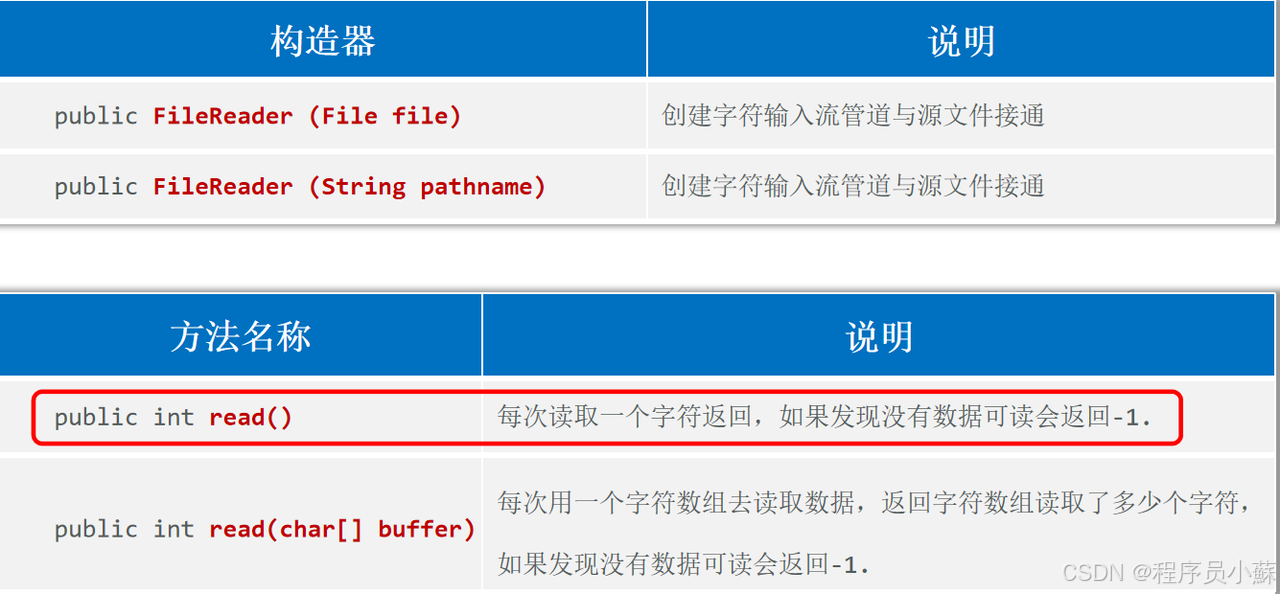
Java
try (//1.获取文件的字符输入流对象
Reader in = new FileReader(new File("module\\a5.txt"))
){
//2.读取字符数据并打印
// int c = in.read();
// System.out.println((char)c);//a
//
// c = in.read();
// System.out.println((char)c);//b
//
// c = in.read();
// System.out.println((char)c);//c
char[] chars = new char[10];
int len = -1;//定义读取字符数组的长度,如果读取不到返回-1
while((len = in.read(chars))!=-1) {
//将读取到的数据输出,注意读取多少长度,输出多少长度,否则会有残留数据输出
System.out.print(new String(chars, 0, len));//注意不要换行,因为文本文件里面有换行
}
}//3.释放资源
catch (Exception e){
e.printStackTrace();
} |
文件字符输出流(FileWriter)
作用:以内存为基准,把内存中的数据以字符的形式写出到文件中去。

Java
try (// 1.获取文件的字符输出流对象
Writer out = new FileWriter(new File("module/a6.txt"));
) {
//2.使用字符输出流写数据
out.write(97);//a
out.write("你好");//你好
out.write("帅气das", 0, 2);//帅气
out.write(new char[]{97,'b','c','尚'});
System.out.println("\r\n");
out.write(new char[]{97,'b','c','尚'}, 0, 2);//ab
out.flush();//刷新流,确保数据写入到文件(输出流可能有部分数据缓存没有写入文件,这样确保缓存数据也写入文件)
//刷新后继续可以输出数据,注意流关闭后不能再使用流
out.write("\nhello world");
//注意:close方法会先调用flush刷新方法,再进行关闭
} catch (Exception e) {
throw new RuntimeException(e);
} |
字符输出输出流的注意实现:字符输出流写出数据后,必须刷新流,或者关闭流,写出去的数据才能生效。

缓冲流
缓冲字节流
BufferedInputStream缓冲字节输入流和BufferedInputStream缓冲字节输入流
- 原理:缓冲字节输入流自带了8KB缓冲池;缓冲字节输出流也自带了8KB缓冲池

Java
try(
//1.获取文件的字节输入流对象
FileInputStream in = new FileInputStream("源文件地址");
//缓冲字节输入流对象
BufferedInputStream bufferedInputStream = new BufferedInputStream(in);
//2.获取文件的字节输出流对象
FileOutputStream out = new FileOutputStream("新文件地址");
//缓冲字节输出流对象
BufferedOutputStream bufferedOutputStream = new BufferedOutputStream(out);
){
// 3.输入流读取数据输出给输出流
byte[] bytes = new byte[1024];//1KB
int len = 0;//定义读取字节的长度
while((len = bufferedInputStream.read(bytes))!=-1){
bufferedOutputStream.write(bytes,0,len);
}
System.out.println("复制完成");
}catch (Exception e){
e.printStackTrace();
} |
缓冲字符流
BufferedReader缓冲字符输入流
作用:自带8K(8192)的字符缓冲池,可以提高字符输入流读取字符数据的性能。

字符缓冲输入流新增的功能:按照行读取字符

BufferedWriter缓冲字符输出流
作用:自带8K的字符缓冲池,可以提高字符输出流写字符数据的性能。

字符缓冲输出流新增的功能:换行

Java
try (
//1.获取文件的字符输入流对象
Reader in = new FileReader(new File("day03-file-io\\a4.txt"));
//缓冲字符输入流对象
BufferedReader bufferedReader = new BufferedReader(in);
//2.获取文件的字符输出流对象
FileWriter out = new FileWriter(new File("day03-file-io\\a5.txt"));
//缓冲字符输出流对象
BufferedWriter bufferedWriter = new BufferedWriter(out);
){
//3.输入流读取数据输出给输出流
String content = null;
//bufferedReader.readLine() 只是读取每一行的数据(不包含换行)
while((content = bufferedReader.readLine())!=null){
bufferedWriter.write(content);//只是输出数据
//换行
bufferedWriter.newLine();//注意:输出的时候手动添加换行
}
}catch(Exception e){
e.printStackTrace();
} |
性能分析
原始流、缓冲流的性能分析
测试用例:
- 分别使用原始的字节流,以及字节缓冲流复制一个很大视频。
测试步骤:
- 使用低级的字节流按照一个一个字节的形式复制文件。
- 使用低级的字节流按照字节数组的形式复制文件。
- 使用高级的缓冲字节流按照一个一个字节的形式复制文件。
- 使用高级的缓冲字节流按照字节数组的形式复制文件。
Java
private static final String SRC_FILE = "想要复制的文件";
private static final String DEST_FILE = "D:\\Test";
public static void main(String[] args) {
// 目标:缓冲流,低级流的性能分析。
// copy01(); // 低级的字节流一个一个字节复制:慢的简直无法忍受,直接淘汰,禁止使用!!
// copy02(); // 使用低级的字节流按照字节数组的形式复制文件: 相对较慢!可以接受
// copy03(); // 使用高级的缓冲字节流按照一个一个字节的形式复制文件:超级慢,直接淘汰
copy04(); // 使用高级的缓冲字节流按照一个一个字节数组的形式复制文件:极快,推荐使用。
}
// 使用低级的字节流按照一个一个字节的形式复制文件。
public static void copy01(){
long start = System.currentTimeMillis(); // 开始时间:返回的是 1970-1-1 0:0:0 走到此刻的总毫秒值。 1s = 1000ms
try (
// 1、创建字节输入流管道与源文件接通
InputStream is = new FileInputStream(SRC_FILE);
// 2、创建字节输出流管道与目标文件接通
OutputStream os = new FileOutputStream(DEST_FILE + "1.wmv");
){
// 3、开始一个一个字节的转移数据
int b;
while ((b = is.read()) != -1){
os.write(b);
}
}catch (Exception e){
e.printStackTrace();
}
long end = System.currentTimeMillis();
System.out.println("低级的字节流按照一个一个字节的形式复制文件耗时:" + (end - start) / 1000.0 + "s");
}
// 使用低级的字节流按照字节数组的形式复制文件。
public static void copy02(){
long start = System.currentTimeMillis(); // 开始时间:返回的是 1970-1-1 0:0:0 走到此刻的总毫秒值。 1s = 1000ms
try (
// 1、创建字节输入流管道与源文件接通
InputStream is = new FileInputStream(SRC_FILE);
// 2、创建字节输出流管道与目标文件接通
OutputStream os = new FileOutputStream(DEST_FILE + "2.wmv");
){
// 3、开始一个一个字节数组的转移数据
byte[] buffer = new byte[1024*8];
int len;
while ((len = is.read(buffer)) != -1){
os.write(buffer, 0, len);
}
}catch (Exception e){
e.printStackTrace();
}
long end = System.currentTimeMillis();
System.out.println("低级的字节数组流按照一个一个字节数组的形式复制文件耗时:" + (end - start) / 1000.0 + "s");
}
//使用高级的缓冲字节流按照一个一个字节的形式复制文件。
public static void copy03(){
long start = System.currentTimeMillis(); // 开始时间:返回的是 1970-1-1 0:0:0 走到此刻的总毫秒值。 1s = 1000ms
try (
// 1、创建字节输入流管道与源文件接通
InputStream is = new FileInputStream(SRC_FILE);
BufferedInputStream bis = new BufferedInputStream(is);
// 2、创建字节输出流管道与目标文件接通
OutputStream os = new FileOutputStream(DEST_FILE + "3.wmv");
BufferedOutputStream bos = new BufferedOutputStream(os);
){
// 3、开始一个一个字节的转移数据
int b;
while ((b = bis.read()) != -1){
bos.write(b);
}
}catch (Exception e){
e.printStackTrace();
}
long end = System.currentTimeMillis();
System.out.println("高级的缓冲字节流按照一个一个字节的形式复制文件耗时:" + (end - start) / 1000.0 + "s");
}
//使用高级的缓冲字节流按照字节数组的形式复制文件。
public static void copy04(){
long start = System.currentTimeMillis(); // 开始时间:返回的是 1970-1-1 0:0:0 走到此刻的总毫秒值。 1s = 1000ms
try (
// 1、创建字节输入流管道与源文件接通
InputStream is = new FileInputStream(SRC_FILE);
BufferedInputStream bis = new BufferedInputStream(is);
// 2、创建字节输出流管道与目标文件接通
OutputStream os = new FileOutputStream(DEST_FILE + "4.wmv");
BufferedOutputStream bos = new BufferedOutputStream(os);
){
// 3、开始一个一个字节数组的转移数据
byte[] buffer = new byte[1024 * 256];
int len;
while ((len = bis.read(buffer)) != -1){
bos.write(buffer, 0, len);
}
}catch (Exception e){
e.printStackTrace();
}
long end = System.currentTimeMillis();
System.out.println("高级的的缓冲字节流按照一个一个字节数组的形式复制文件耗时:" + (end - start) / 1000.0 + "s");
} |
因此,建议使用字节缓冲输入流、字节缓冲输出流,结合字节数组的方式,目前来看是性能最优的组合。
其他流
字符输入转换流(InputStreamReader)[重点]
解决不同编码时,字符流读取文本内容乱码的问题。
解决思路:先获取文件的原始字节流,再将其按真实的字符集编码转成字符输入流,这样字符输入流中的字符就不乱码了

Java
//当前文件 Test01.java(utf-8)使用的 指明以GBK码表读取at.txt(GBK)文件不会乱码
try(
//1.定义字节输入流(原始流,里面的字节没有被破坏)
InputStream inputStream = new FileInputStream("module\\a6.txt");
//2.定义字符输入转换流
InputStreamReader gbk = new InputStreamReader(inputStream,"GBK");
//3.缓冲流提供性能
BufferedReader br = new BufferedReader(gbk);
){
char[] chs = new char[1024];
int len = -1;
while((len = br.read(chs))!=-1){
System.out.println(new String(chs,0,len));
}
}catch(Exception e){
e.printStackTrace();
} |
打印流(PrintStream和PrintWriter)
作用:打印流可以实现更方便、更高效的打印数据出去,能实现打印啥出去就是啥出去。
源码中可以看到里面有缓冲流,所以高效。
例子:97---》a,用打印流就不会转化成a。
PrintStream


Java
try(
//1.定义输出流(注意不要多态,否则无法使用独有方法)
PrintStream printStream = new PrintStream("module\\a7.txt");
){
printStream.println("hello");
printStream.println(100);
printStream.println(true);
printStream.println(3.14);
printStream.println('a');
}catch(Exception e){
e.printStackTrace();
} |
PrintWriter


Java
try(
//1.定义输出流(注意不要多态,否则无法使用独有方法)
PrintWriter printWriter = new PrintWriter("module/a8.txt");
){
printWriter.println("hello");
printWriter.println(100);
printWriter.println(true);
printWriter.println(3.14);
printWriter.println('a');
}catch(Exception e){
e.printStackTrace();
} |
PrintStream和PrintWriter的区别
- 打印数据的功能上是一模一样的:都是使用方便,性能高效(核心优势)
- PrintStream继承自字节输出流OutputStream,因此支持写字节数据的方法。
- PrintWriter继承自字符输出流Writer,因此支持写字符数据出去。
- tomcat(web)服务器响应数据就是使用这个PrintWriter输出流。
特殊数据流(通信时用到)[了解即可]
DataOutputStream(数据输出流)
允许把数据和其类型一并写出去。
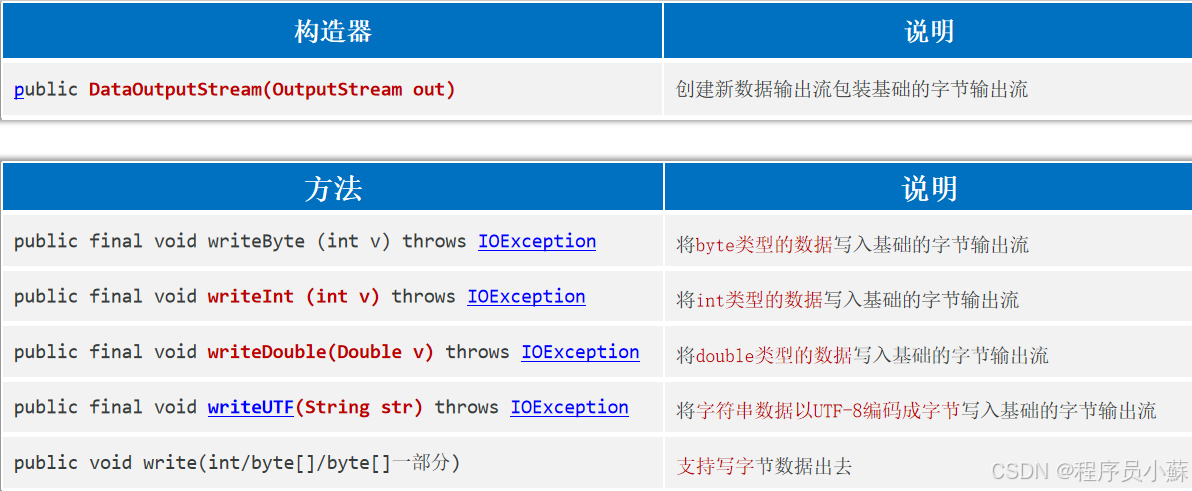
Java
try (
//1.定义资源
FileOutputStream fileOutputStream = new FileOutputStream("module\\a9.txt");
//2.使用特殊数据输出流写出数据
DataOutputStream dataOutputStream = new DataOutputStream(fileOutputStream);
){
dataOutputStream.writeByte(100);
dataOutputStream.writeChar('a');
dataOutputStream.writeDouble(3.14);
dataOutputStream.writeUTF("黑马程序员");
}catch(Exception e){
e.printStackTrace();
} |
DataInputStream(数据输入流)
用于读取数据输出流写出去的数据。
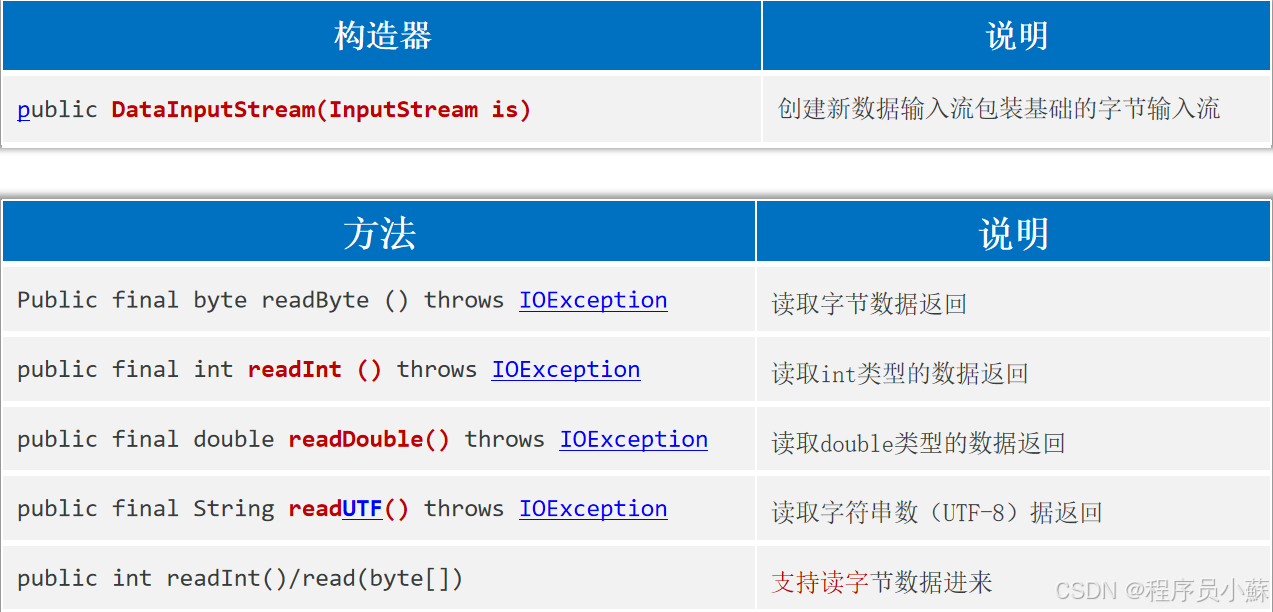
Java
try(
//1..定义资源
FileInputStream fileInputStream = new FileInputStream("module\\a9.txt");
//2.使用特殊数据输入流
DataInputStream dataInputStream = new DataInputStream(fileInputStream);
){
//注意:一定要按照写的顺序读取
int a = dataInputStream.readByte();
char b = dataInputStream.readChar();
double c = dataInputStream.readDouble();
String d = dataInputStream.readUTF();
System.out.println(a);
System.out.println(b);
System.out.println(c);
System.out.println(d);
}catch (Exception e){
e.printStackTrace();
} |
IO框架
- 框架(Framework)是一个预先写好的代码库或一组工具,旨在简化和加速开发过程
- 框架的形式:一般是把类、接口等编译成class形式,再压缩成一个.jar结尾的文件发行出去。
- 封装了Java提供的对文件、数据进行操作的代码,对外提供了更简单的方式来对文件进行操作,对数据进行读写等。
什么是IO框架?
- 封装了Java提供的对文件、数据进行操作的代码,对外提供了更简单的方式来对文件进行操作,对数据进行读写等。
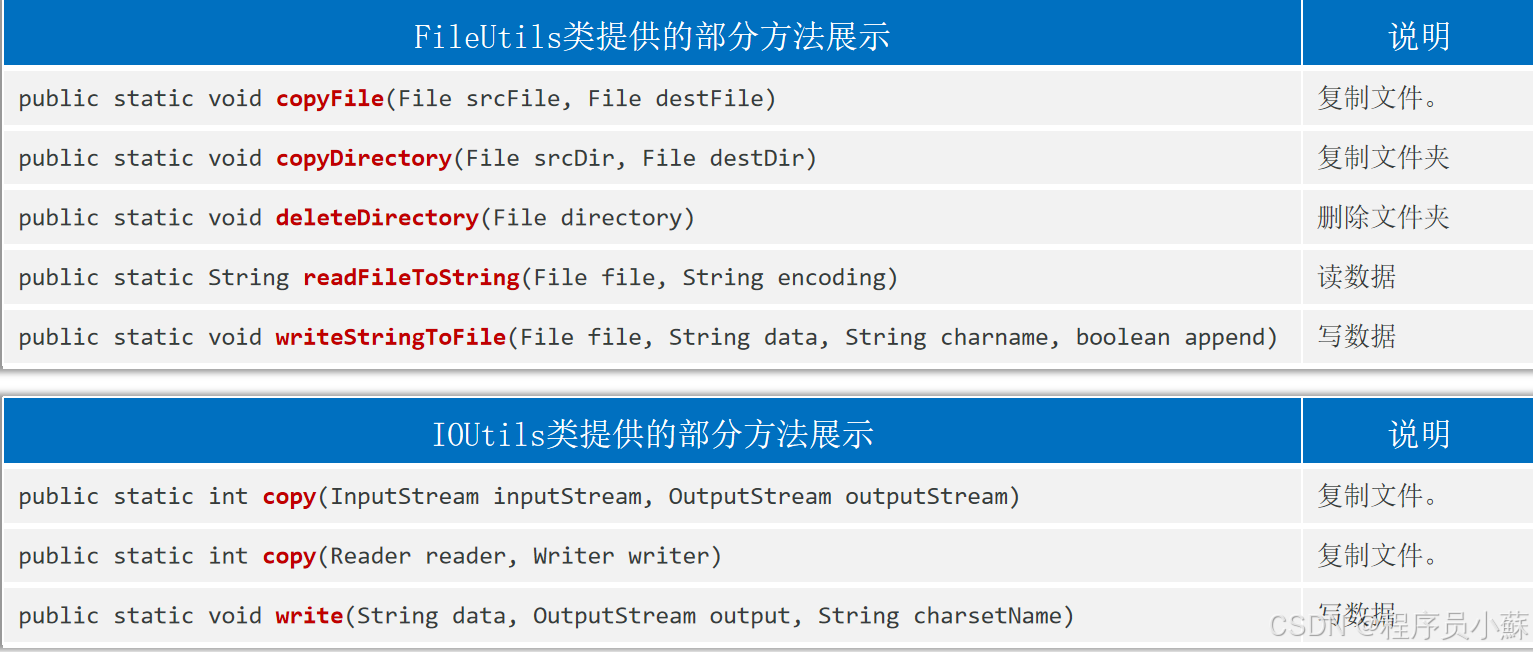
Java
//commons-io包下的IO流框架的使用
//1.一句代码文件复制
FileUtils.copyFile(
new File("源文件地址"),
new File("新文件地址")
);
//2.一句代码文件夹复制
FileUtils.copyDirectory(
new File("源文件夹地址"),
new File("新文件夹地址")
);
//3.一句代码删除非空文件夹
FileUtils.deleteDirectory(new File("文件夹地址"));
//4.jdk7提供新的方式一句代码文件复制
Files.copy(Path.of("源文件地址"), Path.of("新文件地址"));
//5.IOUtils
IOUtils.copy(new FileInputStream("源文件地址"), new FileOutputStream("新文件地址")); |





















